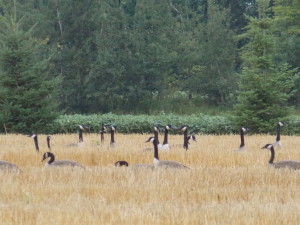We have much more to do and your continued support is needed now more than ever.
No Till, Cover Crops and Wildlife: A Lively Combination
After harvest of winter wheat earlier this year, an interesting thing happened: my field, with the wheat residue remaining and cover crops growing, became migratory waterfowl Mecca.
[youtube]http://www.youtube.com/watch?v=BeyZtr8GHLY[/youtube]
Why was this? Well, simply put, a number of management decisions related to no till and cover crops provided benefits not only to me as a farmer in terms of stable yields in the midst of weird weather and to my downstream neighbors in terms of less fertilizer running off my land causing water quality problems, but also to wildlife.
A Boon for Wildlife

Previous posts have explored the stable yields and water quality benefits of no till and cover crops, and the wildlife activity I observed this fall provides a great opportunity to delve further into the details of this third benefit. As it turns out, the residue which I maintain on the soil surface, rather than tilling it under, not only protects the soil from erosion (which can degrade water quality in waterways), it also provides some habitat to migratory waterfowl.
When I harvested winter wheat earlier this year, I was sure to maintain as much stubble height as possible, minimizing the amount of residue lying down. (When it comes to no till planting, standing residue is easy to manage, it is the stuff lying on the ground that can sometimes cause problems). Having this tall residue provided enough cover for ducks and geese to hunker down. They could hide when they wanted yet also stand up to view their surroundings. Additionally, by not burying that residue into the ground with multiple tillage passes, it remained on the surface, available for the waterfowl to nibble and eat as needed.
For almost a full month, during the peak migration season, a small 10 acre field housed an average of 150 birds per day, with some days over 250 waterfowl nesting and feeding. Some gaggle of geese stayed for five or six days, resting and feeding in preparation for the long flight south.
[youtube]http://www.youtube.com/watch?v=Xe41jj2aTic[/youtube]
In addition to the wheat residue, the cover crops maintained a habitat for the bugs and insects the waterfowl feed upon. I can only imagine the excitement these geese and ducks had when they laid eyes on this field amidst a sea of heavy tillage providing as much wildlife value as the cratered surface of the moon. These simple practices, no till with cover crops, not only provide stable farming and clean water, but also provide helpful habitat and forage for wildlife, providing an oasis on their long journey.
In the coming months, NWF will delve further into the science of cover crops and wildlife. Stay tuned.
Speak up for a sensible Farm Bill
![]() Please make sure that your lawmakers know farm bill conservation is important to you. Send that message to Farm Bill conferees from your state.
Please make sure that your lawmakers know farm bill conservation is important to you. Send that message to Farm Bill conferees from your state.





















